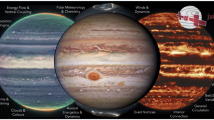Abstract
Jupiter radio emission is known to be the most powerful nonthermal planetary radiation. In recent years specifically space-based observations allow us to permanently cover a large frequency band(from 100 kHz up to 40 MHz combined with ground-based telescopes)of the Jovian spectrum. The Plasma and Wave Science experiment onboard Galileo enables the observation of Jovian kilometric and hectometric emissions; Wind/WAVES and ground-based telescopes (mainly Decametric Array in Nancay, France, and UTR-2 in Kharkov, Ukraine) cover also hectometric and mainly decametric emissions. Specific geometrical configurations between Cassini approaching Jupiter and Wind spacecraft orbiting Earth, with Galileo orbiting Jupiter and Wind, in combination with ground-based observations provide a new approach to perform Jovian radio tomography. The tomography technique is used to analyze ray paths of Jovian radio emission observed in different directions (e.g. solar and anti-solar direction) and for different declination of Earth. The developments of Jovian radio emission tomography in recent years treated refraction effects and its connection to the local magnetic field in the radio source as well as the radio wave propagation through the Io torus and the terrestrial ionosphere. Most recently ground-based multi-site and simultaneous Jupiter decametric radio observations by means of digital spectropolarimeter and waveform receiver provide the basis of a new data analysis treatment. The above addressed topics are without exemption deeply connected to the plasma structures the radio waves are generated in and propagating through.
Similar content being viewed by others
References
Boudjada, M.Y. and Lecacheux, A.: 1991, Faraday rotation of Jupiter's decametric radiation, Astron. Astrophys. 247, 235.
Budden, K.G.: 1985, The Propagation of Radio Waves in the Ionosphere, Univ. Press, Cambridge.
Carr, T.D. and Reyes, F.: 1999, Microstructure of Jovian decametric S bursts, J. Geophys. Res., 25.127.
Dulk, G.A., Lecacheux, A. and Leblanc, Y.: 1992, The complete polarization state of Io-related radio storms from Jupiter: a statistical study, Astron. Astrophys. 253, 292.
Kaiser, M.L., Zarka, P., Kurth, W.S., Hospodarsky, G.B. and Gurnett, D.A.: 2000, Cassini and Wind stereoscopic observations of Jovian nonthermal radio emissions: Measurements of beam widths, J. Geophys. Res. 105, 16053.
Kleewein, P.: 1997, Spectral Analysis of Magnetospheric Radio Emissions, Doctoral Thesis, University of Graz, Austria.
Ladreiter, H.P., Litvinenko, G., Boudjada, M.Y. and Rucker, H.O.: 1995, Faraday rotation in Jupiter's decametric radio emissions used for remote sensing of the terrestrial ionosphere and the emission's source region at Jupiter, Planet. Space Sci. 43, 1595.
Lecacheux, A., Boudjada, M.Y., Rucker, H.O., Bougeret, J.L., Manning, R. and Kaiser, M.L.: 1998, Jovian decametric emissions observed by the Wind/WAVES radio astronomy experiment. Astron. Astrophys. 329, 776.
Leitner, M.: 1999, Waveform Analysis of Radio Emissions in the Decametric Range, Diploma Thesis, University of Graz, Austria.
Queinnec, J. and Zarka, P.: 1998, Io-controlled decametric arcs and Io-Jupiter interaction, J. Geophys. Res. 103, 26.649.
Shaposhnikov, V.E., Boudjada, M.Y., Rucker, H.O., Zaitsev, V.V. and Aubier, M.: 1999, On features of Faraday rotation of the decametric emission in the Jovian magnetosphere, Astron. Astrophys. 344, 709.
Warwick, J.W. and Dulk, G.A.: 1964, Faraday rotation on decametric radio emissions from Jupiter, Science 145, 380.
Author information
Authors and Affiliations
Rights and permissions
About this article
Cite this article
Rucker, H., Boudjada, M., Leitner, M. et al. Developments in Jovian Radio Emissions Tomography and Observations Techniques. Astrophysics and Space Science 277, 325–328 (2001). https://doi.org/10.1023/A:1012258519673
Issue Date:
DOI: https://doi.org/10.1023/A:1012258519673




